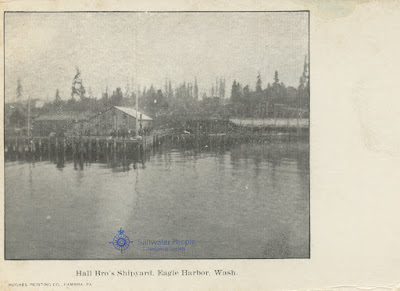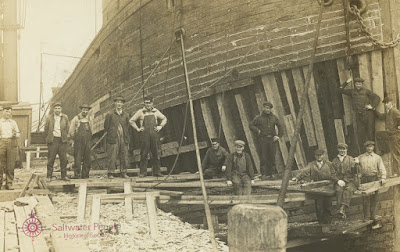"One of the first small shipbuilding yards was located on Whidbey Island where Capt. Thomas Coupe turned out several small schooners at a place that came to be known as Coupeville.
The labor-intensive job of building a sailing vessel in the 1870s went through many phases. Visualization in the form of a wooden half model was the beginning. The model is basic because it allows the builder to see if the shape of the hull will allow water to flow around it and to see how she will ride in the water.
This model is the basis for developing precise drawings, carefully committing the gentle curves of the hull to paper. These curves are called the lines. The drawings are then enlarged, and full-sized wooden patterns for the ribs and timbers are cut.
Usually, in the spring before the thaw, teams of men would head for the woods to select the proper trees, offering strength and clarity, with just the right curves for each rib. It is important that this is done before the sap flows as 'sap-wet wood' will warp and twist.
Next, the backbone of the ship, the keel, the 'focus of strength' is laid, running a hundred feet or more. It must be as straight as an arrow and built of large strong wood logs. Everything rises from the keel, which rests on wood support blocks.
Gradually each rib is fitted, individually, and the skeleton of the great ship takes shape, revealing the lines of the original model. The decking pieces, called floors are placed spanning the area between the ribs.
During the winter months, caulking is prepared from hemp fiber bound with tar, preparatory for filling the chinks in the hull. The caulking is done after the outside planking is accomplished with great care, some are heated so they can be contoured to fit. The twisted hemp, called oakum is twisted and forced into the hull and deck seams with a caulking iron and mallet. Up to seven miles of oakum was often needed to make a vessel watertight.
The hull was then painted with red lead paint and the deck coated with hot tar. The keel was sheathed with copper to protect the wood from worms.
By the time the vessel was ready for launching she would have an identifying name, but be far from seaworthy. She would slide into the water near the yard where she was built, often with the help of a smashed bottle of wine or rum.
Once the ship was launched the work on the interior living quarters was completed, the masts stepped, braced, and rigged, ready to receive the thousands of square feet of sails that had been hand-crafted by skilled sailmakers. Ironmongers had been busy for weeks forging the necessary hardware to handle and hoist the sails. With the installation of pumps, anchors, and other necessary equipment the vessel was ready to receive supplies for the first voyage and set sail.
The needs for thirty men for four years were then stored in the belly of the ship: 100 barrels each of salt beef and pork, 131 barrels of flour, 2000 gallons of molasses, 1,119 pounds of coffee, 24,000 cigars, 39 pecks of salt, 172 pounds of nutmeg, 36 pounds ginger, 319 pounds of tea, 864 buttons, three dozen suspenders, and the traditional supply of rum."
Island County Historial Society. Sails, Steamships, & Sea Captains. 1993. Coupeville, WA. pp 60-62.
The sixteen photographic images are from the archives of the Saltwater People Log.
On this website readers can also view some data and photos on a post of the Skansie Brothers Shipyard, Gig Harbor, WA. by clicking HERE.
And a post for San Juan County's Jensen Shipyard can be seen HERE.
 |
Matthews Ship Building Co. Hoquiam, Pierce County, WA. |
 |
The Matthews Shipyard, Hoquiam, WA. 25 May 1916. |
 |
HALL BROTHERS SHIPYARD, Eagle Harbor, Kitsap County, WA. |
The labor-intensive job of building a sailing vessel in the 1870s went through many phases. Visualization in the form of a wooden half model was the beginning. The model is basic because it allows the builder to see if the shape of the hull will allow water to flow around it and to see how she will ride in the water.
This model is the basis for developing precise drawings, carefully committing the gentle curves of the hull to paper. These curves are called the lines. The drawings are then enlarged, and full-sized wooden patterns for the ribs and timbers are cut.
Usually, in the spring before the thaw, teams of men would head for the woods to select the proper trees, offering strength and clarity, with just the right curves for each rib. It is important that this is done before the sap flows as 'sap-wet wood' will warp and twist.
Next, the backbone of the ship, the keel, the 'focus of strength' is laid, running a hundred feet or more. It must be as straight as an arrow and built of large strong wood logs. Everything rises from the keel, which rests on wood support blocks.
 |
| This work underway was for a large vessel, comparing the size of the men to the big frames. Click image to enlarge. Raymond, WA. Photo dated 1913. |
 |
Big seasoned timbers being readied for fitting. Aberdeen Shipyard, Gray's Harbor County, WA. Click image to enlarge. |
 |
More big timbers being prepared, WA. |
 |
Huge timbers lined up for several ships being built. Vancouver, Clark County, WA. Click image to enlarge. |
 |
Planking going on. Unknown shipyard. |
 |
Lindstrom Shipyard, Aberdeen, WA. Founded by John Lindstrom & C.E. Green in 1899. Closed in 1907. Click image to enlarge. |
 |
W. J. Patterson (81735) Loading at American Mill Co, Hoquiam, Pierce County, WA. 645 G.t. Built by Lindstrom Shipyard in 1901. |
The hull was then painted with red lead paint and the deck coated with hot tar. The keel was sheathed with copper to protect the wood from worms.
By the time the vessel was ready for launching she would have an identifying name, but be far from seaworthy. She would slide into the water near the yard where she was built, often with the help of a smashed bottle of wine or rum.
 |
Building and launching at The Foundation Company Shipyards, Tacoma, Pierce County, WA. Click image to enlarge. |
Once the ship was launched the work on the interior living quarters was completed, the masts stepped, braced, and rigged, ready to receive the thousands of square feet of sails that had been hand-crafted by skilled sailmakers. Ironmongers had been busy for weeks forging the necessary hardware to handle and hoist the sails. With the installation of pumps, anchors, and other necessary equipment the vessel was ready to receive supplies for the first voyage and set sail.
The needs for thirty men for four years were then stored in the belly of the ship: 100 barrels each of salt beef and pork, 131 barrels of flour, 2000 gallons of molasses, 1,119 pounds of coffee, 24,000 cigars, 39 pecks of salt, 172 pounds of nutmeg, 36 pounds ginger, 319 pounds of tea, 864 buttons, three dozen suspenders, and the traditional supply of rum."
Island County Historial Society. Sails, Steamships, & Sea Captains. 1993. Coupeville, WA. pp 60-62.
The sixteen photographic images are from the archives of the Saltwater People Log.
On this website readers can also view some data and photos on a post of the Skansie Brothers Shipyard, Gig Harbor, WA. by clicking HERE.
And a post for San Juan County's Jensen Shipyard can be seen HERE.










No comments:
Post a Comment